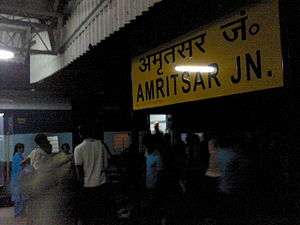Samjhauta Express
| Samjhauta Express | ||||||||||||||||||||||||||||||||||||||||||||||||||||||||||||||||||||
|---|---|---|---|---|---|---|---|---|---|---|---|---|---|---|---|---|---|---|---|---|---|---|---|---|---|---|---|---|---|---|---|---|---|---|---|---|---|---|---|---|---|---|---|---|---|---|---|---|---|---|---|---|---|---|---|---|---|---|---|---|---|---|---|---|---|---|---|---|
|
Pakistani Rakes of Samjhauta Express | ||||||||||||||||||||||||||||||||||||||||||||||||||||||||||||||||||||
| Overview | ||||||||||||||||||||||||||||||||||||||||||||||||||||||||||||||||||||
| Termini |
Lahore Delhi | |||||||||||||||||||||||||||||||||||||||||||||||||||||||||||||||||||
| Stations | Amritsar, Lahore | |||||||||||||||||||||||||||||||||||||||||||||||||||||||||||||||||||
| Operation | ||||||||||||||||||||||||||||||||||||||||||||||||||||||||||||||||||||
| Operator(s) |
Pakistan Railways Indian Railways | |||||||||||||||||||||||||||||||||||||||||||||||||||||||||||||||||||
| Technical | ||||||||||||||||||||||||||||||||||||||||||||||||||||||||||||||||||||
| Track gauge | Indian Gauge 5 ft 6 in | |||||||||||||||||||||||||||||||||||||||||||||||||||||||||||||||||||
| ||||||||||||||||||||||||||||||||||||||||||||||||||||||||||||||||||||


The Samjhauta Express (Hindi: समझौता एक्सप्रेस, Urdu: سمجھوتا اکسپريس Punjabi language: ਸਮਝੌਤਾ ਐਕਸਪ੍ਰੈਸ / سمجھوتا اکسپريس ) commonly called the Friend Express, is a twice-weekly train – Tuesdays and Fridays – that runs between Delhi and Attari in India and Lahore in Pakistan. The word Samjhauta means "agreement", "accord" and "compromise" in both Hindi and Urdu.
Until the reopening of the Thar Express, this was the only rail connection between the two countries. The train was started on 22 July 1976 following the Shimla Agreement and ran between Amritsar and Lahore, a distance of about 42 km. Following disturbances in Punjab in the late eighties, due to security reasons Indian Railways decided to terminate the service at Attari, where customs and immigration clearances take place. On 14 April 2000, in an agreement between Indian Railways and Pakistan Railways (PR), the distance was revised to cover just under three km.
It was a daily train when the service started, and changed to a bi-weekly schedule in 1994. Earlier the rakes were returned to the home country the same day but later in 2000 the rake remained overnight at that location.
Its termini are Lahore in Pakistan and Delhi in India. The border crossing takes place between Wagah in Pakistan and Attari in India. Originally, this was a through service with the same rake going all the way between the termini; later the Pakistani rake stopped at Attari at which point passengers had to change trains.
Now there is a train from Delhi to Attari where all passengers alight for customs and immigration. This train does not have any commercial stops between Delhi and Attari. It is incorrectly referred to as the Samjhauta Express and it is officially known as the Delhi-Attari or Attari-Delhi Express. The actual Samjhauta Express runs from Attari to Lahore, although the passengers are checked at Wagah, the first station on the Pakistani side. The train service was set up with an agreement between Indian Railways (IR) and Pakistan Railways (PR) to alternately use an Indian and a Pakistani rake and locomotive for the train, six months at a time.
The train usually has between four and eight coaches. The rake supplied by Pakistan is usually hauled by an Alco DL-543 class ALU20 diesel loco (Lahore shed), with the entire train in the standard dark green livery of PR.
The train's first break of service was when it was discontinued on 1 January 2002 in the wake of the terrorist attack on the Indian Parliament on 13 December 2001. Service resumed on 15 January 2004. Service was also suspended following the 27 December 2007, assassination of Benazir Bhutto as a preventive measure to deny militants a "high-value target" that was of great symbolic importance to both India and Pakistan.[1]
On 8 October 2012, police recovered about 100 kg of contraband heroin and more than 500 rounds of bullet ammunition at Wagah border on the train heading for Delhi.[2][3]
2007 bombing
In the early hours of 19 February 2007, sixty-eight people (mostly Pakistani civilians and a few Indian military guarding the train) were killed and scores more injured in a terrorist attack on the Delhi - Attari Express.[4][5] The attack occurred at Diwana station near the Indian city of Panipat, Haryana. Officials found evidence of improvised explosive devices (IEDs) and flammable material, including three unexploded IEDs. The National Investigation Agency doubted that the blasts were masterminded by Swami Aseemanand, which was dismissed later for lack of evidence. Swami Aseemanand born as Jatin Chatterjee in West Bengal, joined the Vanvasi Kalyan Ashram, inspired by the Rashtriya Swayamsevak Sangh in 1978.[6]
On 1 July 2009, the US Department of Treasury designated Arif Qasmani of the Lashkar-e Tayyiba as a person involved in terrorism, citing among other things his involvement in the Samjhauta Express bombing.[7]
On 30 December 2010, India's National Investigation Agency claimed that they had solid evidence that Swami Aseemanand was the mastermind behind the blasts. He had roped in Sandeep Dange, an engineering graduate, and Ramji Kalsangra, an electrician, to build the improvised explosive devices used in the blasts.[6] On 8 January 2011, Aseemanand allegedly confessed the bombing of Samjhauta express,[8] a statement later found to be obtained under duress.[9] Later the Hindu nationalist group RSS (Rashtriya Swayamsevak Sangh) sent a legal notice to CBI (Central Bureau of Investigation) accusing it of deliberately leaking Swami Aseemanand's confession in the media. RSS spokesman Ram Madhav called the investigation maligning of organizations and individuals.[10]
According to various local newspapers, NIA arrested Kamal Chauhan, who is deemed by the NIA as the main operative, in February 2012.
External links and references
- ↑ The Telegraph - Calcutta (Kolkata) | Frontpage | India waits, steps up Pak vigil
- ↑ Rs.505 crore drug bust from India-bound Samjhauta Express Vikas Kahol, Mail Today, Chandigarh, 8 October 2012, indiatoday.intoday.in
- ↑ Heroine worth R 505 crore, ammunition seized from Samjhauta Express, Chandigarh, 8 October 2012, Dailybhaskar.com
- ↑ http://www.hindustantimes.com/news/181_1931712,0008.htm
- ↑ Zee News - Passengers recount horror on blast-hit train
- 1 2 "Direct hand of Aseemanand in Samjhauta blasts: NIA". Hindustan Times. 2010-12-30. Retrieved 2012-02-05.
- ↑ "Treasury Targets Al Qaida and Lashkar-E Tayyiba Networks in Pakistan". Treasury.gov. Retrieved 2012-02-05.
- ↑ Vishwa Mohan; Abantika Ghosh (8 January 2011). "Aseemanand owns up to strike on Mecca Masjid". Times of India. Retrieved 8 January 2011.
- ↑ Swami Aseemanand 'confessed' under duress Times of India - 10 January 2011
- ↑ Iyer, Shekhar (8 January 2011). "Indresh lawyers issue notice to CBI for statement 'leak'". Hindustan Times. Retrieved 8 January 2011.